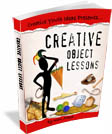This lesson uses ping pong balls to remind us that as Christians we can be easily tossed around, unstable, blown off course if we lack faith. But through prayer and belief we can be strong enough to face and stand strong in any difficulties and circumstances we might face as Christians.
PLEASE CLICK HERE TO SHARE THIS YOUTH IDEA ON FACEBOOK
Games using Ping Pong Balls
- Balance – Who can balance a ping pong ball on a book (through an obstacle course?) without the ball falling off?
- Bounce off – From a designated distance, bounce a ping pong ball at another ping pong ball to knock it off an open soda bottle. First to do so wins.
- Bridge Run – Be the first to roll three ping pong balls into three different glasses set at varying distances, using a tape measure as a bridge. When the game begins, grab the tape measure and extend it towards the nearest glass. Pick up a ping pong ball and try to roll it across the tape measure and into the glass. Once you’ve found success with the first glass, move on to the next one. In order to win this game, all three glasses must contain ping ping balls and the tape measure must be retracted. The trick is getting the right angle – if the angle is too steep the ball will roll too quickly and right across the glass.
- Double shot – Using 1 hand, toss 2 Ping balls at the same time so that they land in 2 separate glasses.
- Fan Propulsion – Using a paper plate, be the first to fan a ping pong ball across a goal line.
- Ping Pong Ball Catch – Holding a cup on top of your head, you try to be the first to catch a ping pong ball in the cup on top of your head as the ball is bounced off the floor and into the air. Harder than it seems.
- Ping Pong in a cup – players stand at 10 – 20 feet apart in a room with a tile or concrete floor. One player bounces the ball toward the other who must catch the ball in a cup before it stops bouncing. The ball can only be touched with the cup.
- Ping Pong Knock Out – everyone holds a plastic spoon in their mouth with a ping pong ball balanced on it. Using only blasts of air, each youth must blow the ping pong balls off the spoons of other youth. Last one with left with his or her ping pong ball on the spoon is the winner. (The difficult is sudden movements can drop the ball as quickly as a gust of air. And those gusts of air just might blow your own ping pong ball off the spoon) No physical contact is allowed.
- Ping-Pong Ball Flick – Place a ping pong ball on top of an open soda bottle. Youth must quickly walk past with their arm straight out and try to flick the ball off without touching the bottle. Its more difficult than it seems.
- Ropeway – Two team members hold a long loop of string taught with their hands and try to be the first to roll a ping pong ball to one end and back without dropping it.
- Shake a box – Place 6 to 10 ping pong balls in an empty tissue box. (If needed, enlarge the hole in the top of the tissue box so it is big enough but not too big for a ping pong ball to fit through. Fill the box with 6 to 10 ping pong balls and attach it to the back of a youth using a piece of string or duct tape so that the bottom of the box is against the person’s waist / backside. Youth must dance around to shake the balls out of the box. First to do so wins.
- Spoon & Ping Pong Ball Relay – A youth holds a spoon in his mouth and carries the ball through an obstacle course. Fast team to do so wins. (Variation – do it blindfolded with verbal instructions from your team)
- Spoon Transport – A ping pong ball is passed player to player on a spoon. If the ball falls, the team must start over again at the beginning. (Variation – spoons are held in the mouth)
- Straw Propulsion – Use a straw to blow a ping pong ball through an obstacle course on a table or the floor to a goal.
- String Transport – Be the first to transport a ping pong ball sitting on top of an open soda bottle to another soda bottle that is several feet away using only a loop of string. (Use 36 inches / 1 meter of string with the ends tied together to create a loop. With your fingers inside of each end of the loop of string you can stretch it out to a long oval that can hold the ping pong ball in balance.) You cannot touch it with your hands. You drop it then you must start over.
- Table Tennis Ball Goal Shoot – Set up goal markers on opposite sides of a table with team members alternating around it. Using only gusts of air, which team can shoot the ping pong ball into the most goals in a designated time limit.
- Tic Tac Toe – Arrange 9 paper cups in a 3×3 grid for each team. The first team to bounce ping pong balls into the cups to get 3 in a row wins.
- Wasted – Who can be the first to toss a ping pong ball against the wall so that it then bounces into a waste paper basket?
- William Tell – From a designated distance, use a rubber band to shoot the ping pong ball off of an open soda bottle. First to do so wins.
TAKE IT TO THE NEXT LEVEL
MAKE IT SPIRITUAL
- What were some of the difficulties that you faced in these games?
- What were some of the strategies used to overcome the difficulties?
- What are some of the characteristics of a ping pong ball that had an effect on these games?
The difficulty with Ping Pong Balls is that they bounce back and forth easily – Ping – Pong – Ping – Pong and they are easily blown off course.
The Bible describes a man who has these same qualities in James 1:5-8
“If any of you lacks wisdom, you should ask God, who gives generously to all without finding fault, and it will be given to you. But when you ask, you must believe and not doubt, because the one who doubts is like a wave of the sea, blown and tossed by the wind. That person should not expect to receive anything from the Lord. Such a person is double-minded and unstable in all they do.”
When you don’t have faith in God, you’ll be double minded. That means, like a ping-pong ball, you’ll bounce back and forth. You won’t be strong in your faith. You’ll be tossed about by doubts and difficulties.
MAKE IT PRACTICAL
- What are some of the difficulties we face as Christians? In school? In our homes? In life? In general?
- What are some ways we can overcome the various difficulties?
- How is faith and prayer an answer to facing life’s difficulties?
- What are some of the doubts we face concerning God and prayer?
- How do doubts affect a person’s prayer life? Our actions?
- Are you easily influenced by circumstances and thing around you? Why or why not?
- Are you able to stand strong in life’s difficulties? Why or why Not?
- What solutions does this scripture give us?
MAKE IT PERSONAL
- In what areas do you need God’s wisdom this week?
- In what areas do you need to be more consistent, more stable?
- How can faith and prayer help you in these things?
SCRIPTURE VERSES on Doubts / Lack of Faith
- Matthew 14:31 – Peter walks on water and doubts
- Mark 4:40 – Jesus calms the storm
PLEASE CLICK HERE TO SHARE THIS YOUTH IDEA ON FACEBOOK
 MORE IDEAS? See “Creative Object Lessons”
MORE IDEAS? See “Creative Object Lessons”
200 page e-book that explains everything you need to know when planning your very own object lessons. It contains 90 fully developed object lesson ideas and another 200 object lesson starter ideas based on Biblical idioms and Names / Descriptions of God.
![]()


